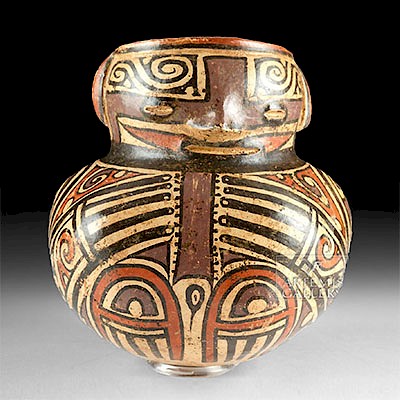Roman Brass Plaque: Hercules, Atlas & Hesperides Apples
Lot 26b
About Seller
Artemis Fine Arts
686 S Taylor Ave, Ste 106
Louisville, CO 80027
United States
Selling antiquities, ancient and ethnographic art online since 1993, Artemis Gallery specializes in Classical Antiquities (Egyptian, Greek, Roman, Near Eastern), Asian, Pre-Columbian, African / Tribal / Oceanographic art. Our extensive inventory includes pottery, stone, metal, wood, glass and textil...Read more
Estimate:
$1,200 - $1,500
Absentee vs Live bid
Two ways to bid:
- Leave a max absentee bid and the platform will bid on your behalf up to your maximum bid during the live auction.
- Bid live during the auction and your bids will be submitted real-time to the auctioneer.
Bid Increments
| Price | Bid Increment |
|---|---|
| $0 | $25 |
| $300 | $50 |
| $1,000 | $100 |
| $2,000 | $250 |
| $5,000 | $500 |
| $10,000 | $1,000 |
| $20,000 | $2,500 |
| $50,000 | $5,000 |
| $100,000 | $10,000 |
| $200,000 | $20,000 |
About Auction
By Artemis Fine Arts
Nov 8, 2018
Set Reminder
2018-11-08 10:00:00
2018-11-08 10:00:00
America/New_York
Bidsquare
Bidsquare : Ancient / Ethnographic From Around The World
https://www.bidsquare.com/auctions/artemis-gallery/ancient-ethnographic-from-around-the-world-3598
Ancient art from Egypt, Greece, Italy and the Near East, as well as Asian, Pre-Columbian, Native American, African / Tribal / Oceanic, Spanish Colonial, Russian Icons, Fine art, much more! Artemis Fine Arts info@artemisgallery.com
Ancient art from Egypt, Greece, Italy and the Near East, as well as Asian, Pre-Columbian, Native American, African / Tribal / Oceanic, Spanish Colonial, Russian Icons, Fine art, much more! Artemis Fine Arts info@artemisgallery.com
- Lot Description
Roman, Imperial Period, ca. 1st to 3rd century CE. An interesting cast-brass plaque of a rectangular form with a raised obverse border and a planar verso with two worn attachment prongs. The obverse face depicts a relief scene of the mythical hero Hercules (Greek Herakles) and the Titan Atlas, the bearer of the heavens, during one of Hercules' twelve labors: stealing the apples of the Hesperides. Hercules is shown on the right wearing the pelt of the Nemean Lion and holding a large, curved club in one hand while Atlas supports a huge cluster of apples in his classic globe-bearing pose. The plaque is covered in thick layers of green and russet patina. Custom museum-quality display stand included. Size: 3.1" W x 2.2" H (7.9 cm x 5.6 cm); 3" H (7.6 cm) on included custom stand.
This scene shows Atlas holding a cluster of apples from the gardens of his daughters, the Hesperides, who were described in mythology as the "nymphs of the west" and "daughters of the evening." Hercules requested Atlas assist him with this labor, and Atlas agreed by bargaining to pick the apples if Hercules would hold the skies for a while. Hercules, at the advice of Nereus, the old man of the sea, only pretended to accept the deal as he remembered that Atlas would do most anything to rid himself of the punishment handed down as a result of the Titanomachy. Once Atlas had picked the apples, Hercules asked for a brief reprieve to make a small padding from his lion pelt to make the task more comfortable. Atlas agreed and took the skies back, only to realize that he himself had been deceived into resuming the one task he despised the most.
Provenance: private East Coast, USA collection
All items legal to buy/sell under U.S. Statute covering cultural patrimony Code 2600, CHAPTER 14, and are guaranteed to be as described or your money back.
A Certificate of Authenticity will accompany all winning bids.
We ship worldwide and handle all shipping in-house for your convenience.
#137142Minor nicks to peripheries and raised scene, wear to attachment prongs on verso, with light fading to finer details, and light encrustations, otherwise intact and very good. Light earthen deposits and great green and russet patina throughout.Condition
- Shipping Info
-
All shipping is handled in-house for your convenience. Your invoice from Artemis Gallery will include shipping calculation instructions. If in doubt, please inquire BEFORE bidding for estimated shipping costs for individual items.
-
- Buyer's Premium



 EUR
EUR CAD
CAD AUD
AUD GBP
GBP MXN
MXN HKD
HKD CNY
CNY MYR
MYR SEK
SEK SGD
SGD CHF
CHF THB
THB














